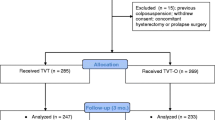Abstract
A mailed questionnaire was sent to 970 consecutive women who underwent a tension-free vaginal tape (TVT) procedure between 1995 and 2001 at the Department of Obstetrics and Gynecology in Falun Hospital. Seven hundred and sixty (78.4%) women responded. The outcome was compared between women older than 75 years (n=113) and younger women, and between women with a body mass index (BMI) above 35 (n=61) and those who had normal weight. Mean follow-up was 5.7 years. Thirty-six elderly women and one of the obese women were deceased at the long-term follow-up. TVT was easy to perform and was a safe procedure for women in all groups. There was a sharp decrease in cure rate of any urinary incontinence problems among women aged 75 years or more (55.7%), as compared to those who were younger (79.7%). The cure rate moderately decreased from BMI groups 19–24 to 30–34. BMI ≥35 seemed to be the best explanatory cutoff level. The overall cure rate in women of normal weight was 81.2%, as compared to 52.1% in the very obese. The cure rate for urinary incontinence with tension-free vaginal tape in women above 75 years of age and in women with a BMI above 35 was acceptable, but lower as compared to the remaining study population.


Similar content being viewed by others
References
Cobbs EL, Ralapati AN (1998) Health of older women. Med Clin North Am 82:127–144
Ulmsten U, Petros P (1995) Intravaginal slingplasty (IVS): An ambulatory surgical procedure for treatment of female urinary incontinence. Scand J Urol Nephrol 29:75–82
Karantanis E, Fynes MM, Stanton SL (2004) The tension-free vaginal tape in older women. BJOG 111:837–841
Mokdad AH, Serdula MK, Dietz WH, Bowman BA, Marks JS, Kopkan JP (1999) The spread of the obesity epidemic in the United States, 1991–1998. JAMA 282:1519–1522
Lawrence VJ, Kopelman PG (2004) Medical consequences of obesity. Clin Dermatol 22:296–302
Mukherjee K, Constantine G (2001) Urinary stress incontinence in obese women: tension-free vaginal tape is the answer. BJU Int 88:881–883
Falconer C, Ekman-Ordeberg G, Ulmsten U, Westergren-Thorsson G, Barchan K, Malmström A (1996) Changes in paraurethral connective tissue at menopause are counteracted by estrogen. Maturitas 24:197–204
Milsom I, Ekelund P, Molander U, Arvidsson L, Areskoug B (1993) The influence of age, parity, oral contraception, hysterectomy and menopause on the prevalence of urinary incontinence in women. J Urol 149:1459–1462
Milsom I, Abrams P, Cardozo L, Roberts RG, Thuroff J, Wein AJ (2001) How widespread are the symptoms of an overactive bladder and how are they managed? A population-based prevalence study. BJU Int 87:760–766
Lo TS, Huang HJ, Chang CL, Wong SY, Horng SG, Liang CC (2002) Use of intravenous anesthesia for tension-free vaginal tape therapy in elderly women with genuine stress incontinence. Urology 59:349–353
Allahdin S, McKinley CA, Mahmoud TA (2004) Tension-free vaginal tape: a procedure for all ages. Acta Obstet Gynecol Scand 83:937–940
Bombieri L, Freeman RM, Perkins EP, Williams MP, Shaw SR (2002) Why do women have voiding dysfunction and de novo detrusor instability after colposuspension? BJOG 109:402–412
Noblett KL, Jensen JK, Ostergard DR (1997) The relationship of body mass index to intra-abdominal pressure as measured by multichannel cystometry. Int Urogynecol J Pelvic Floor Dysfunct 8:323–326
Subak LL, Johnson C, Whitcomb E, Boban D, Saxton J, Brown JS (2002) Does weight loss improve incontinence in moderately obese women? Int Urogynecol J Pelvic Floor Dysfunct 13:40–43
Cummings JM, Rodning CB (2000) Urinary stress incontinence among obese women: Review of pathophysiology therapy. Int Urogynecol J Pelvic Floor Dysfunct 11:41–44
Lovatsis D, Chander G, Dean E, Lee F (2003) Tension-free vaginal tape procedure is an ideal treatment for obese patients. Am J Obstet Gynecol 189:1601–1605
Rafii A, Darai E, Haab F, Samain E, Levardon M, Deval B (2003) Body mass index and outcome of tension-free vaginal tape. Eur Urol 43:288–292
Cummings JM, Boullier JA, Parra RO (1998) Surgical correction of stress incontinence in morbidly obese women. J Urol 160:754–755
Author information
Authors and Affiliations
Corresponding author
Rights and permissions
About this article
Cite this article
Hellberg, D., Holmgren, C., Lanner, L. et al. The very obese woman and the very old woman: tension-free vaginal tape for the treatment of stress urinary incontinence. Int Urogynecol J 18, 423–429 (2007). https://doi.org/10.1007/s00192-006-0162-2
Received:
Accepted:
Published:
Issue Date:
DOI: https://doi.org/10.1007/s00192-006-0162-2




